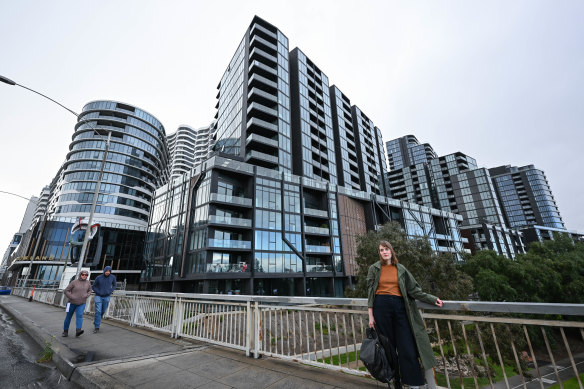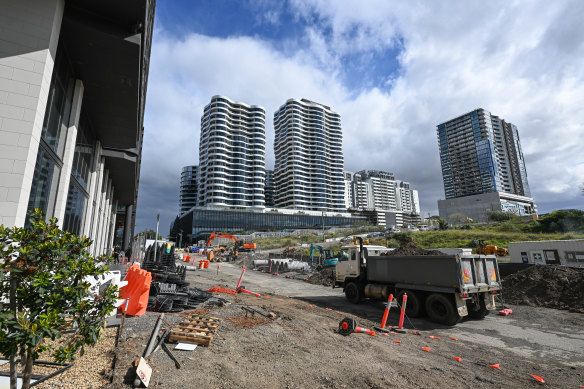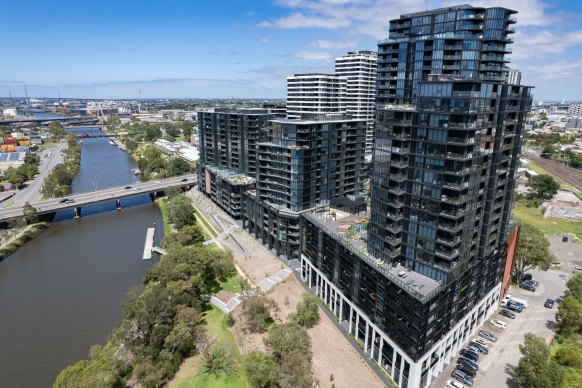At the gateway to the west, about a dozen high-rises of up to 30 storeys tower over Footscray.
In this inner-city neighbourhood, called the Joseph Road precinct, the streets are windswept and devoid of trees. Some roads remain unsealed and footpaths unfinished, the ground levels are largely lifeless, and several blocks still sit idle.

Urban Design Forum president Katherine Sundermann stands at the Hopkins Street bridge.Credit: Joe Armao
Widely seen by planners as one of Victoria’s worst examples of urban renewal, there are fears Melbourne could see more of this kind of “disaster” after the state government issued housing targets that would force many councils to more than double their housing stock over the next three decades.
In a submission to the Allan government’s Plan for Victoria development road map, Maribyrnong council warned Footscray’s Joseph Road precinct – a 15-hectare parcel bordered by the Maribyrnong River, traffic-logged Hopkins Street and the Footscray railway – is an appropriate case study of poor planning.
Maribyrnong City Council, which takes in Footscray, Yarraville, Kingsville and Braybrook, was set a target of 49,000 new homes by 2051 – a 114 per cent jump from current levels.
The target would mean building an average of more than 1800 new homes in the municipality each year.
The council’s Plan for Victoria submission points out that the last time 1800 new homes had been achieved in one year was in 2016, when the state approved several hundred more apartments at the Joseph Road precinct.
The project had been super-charged three years earlier, in 2013, when former Liberal government planning minister Matthew Guy approved new rules that paved the way for skyscrapers to be built on the brownfield site.
“The way [the Joseph Road precinct] was done was completely how you shouldn’t do it,” said Michael Clarke, a long-serving Maribyrnong councillor.
Clarke said he understood the need for high housing targets but to avoid “disaster” required careful, staged planning.

The Joseph Road precinct needs significant public infrastructure works.Credit: Joe Armao
“You don’t just build buildings, you make sure there is infrastructure in place that will aid … a healthy community.
“What we want to know is what is the state government’s skin in the game ... we can’t simply leave the management of the growth in the hands of local ratepayers.”
Maribyrnong council is scathing of the absence of early planning for the precinct’s liveability.
“The Joseph Road precinct example serves as a valuable case study of the risk of poor planning outcomes resulting from inflating residential densities without implementing timely infrastructure and public realm upgrades,” its submission says.

Apartment developments along the Maribyrnong River at the Joseph Road precinct.Credit: Jason South
“Residents moving into this area on day one rightly expected that basic services such as footpaths, drainage and lighting would be provided ... This situation cannot be allowed to repeat.”
A developer levy was introduced in 2019 to fund basic infrastructure including footpaths, better roads, landscaping and street furniture.
Maribyrnong council chief executive Celia Haddock said $13.3 million had been collected by the levy so far, with a small park completed last month.
A spokeswoman for Planning Minister Sonya Kilkenny blamed the previous Liberal government for failing to implement an infrastructure strategy for Joseph Road.
She said the government had improved apartment design standards and was undertaking the biggest consultation project in Victoria’s history. The targets set for each area were a draft, she said, with councils invited to provide feedback.
Patrick Fensham, president of the Planning Institute of Australia’s Victorian division, said the Joseph Road precinct was a valuable lesson in why forward-thinking on infrastructure and amenity was necessary.
Fensham said high-density development must have minimum standards for open space, tree canopy, walkability, reduced car parking and affordable housing.
“When there is emphasis only on maximising dwelling numbers, there’s always a danger that the supporting infrastructure won’t be provided.”
Urban Design Forum president Katherine Sundermann said plans for Joseph Road to become a thriving, mixed-use neighbourhood never eventuated because land was rezoned and sites were sold without first locking in how to deliver public improvements.
“It’s sad. That was quite a large site that could have been thought about comprehensively,” Sundermann said.
“That’s home for many people, and they’re dealing with a wind-swept, overshadowed place.
“We’re definitely at risk of continuing in the same vein if we continue to focus only on housing. We don’t want to be in the position that the City of Maribyrnong is in of trying to play catch-up.”
Many councils are criticising the government’s housing targets for failing to account for desperately needed infrastructure.
Boroondara council, which takes in Kew, Camberwell and Hawthorn, was assigned a draft target of 67,000 dwellings by 2051 – a 90 per cent increase in the existing dwellings.
The council’s submission labelled the government’s plans “short-sighted”, with potential long-term negative impacts to Melbourne’s famed liveability.
“To release housing targets on the scale proposed ... without making any commitment to the infrastructure required to support such exceptional growth is irresponsible planning,” it wrote.